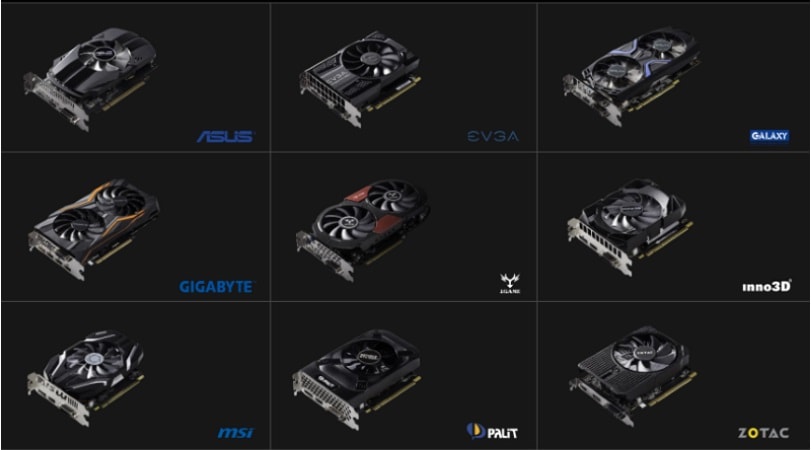- Home
- Laptops
- Laptops News
- Nvidia GeForce GTX 1050 and GTX 1050Ti Launched Starting at Rs. 10,000
Nvidia GeForce GTX 1050 and GTX 1050Ti Launched Starting at Rs. 10,000

Nvidia has finally launched its entry-level GeForce GTX 1050 and GeForce GTX 1050Ti GPUs, rounding out the 10-series family which has so far been comprised mainly of high-end products. The new GPUs target entry-level gamers as well as those who are either upgrading an old PC or considering moving away from consoles.
Recommended US pricing has been set at $109 for the GeForce GTX 1050 and $139 for the GeForce GTX 1050 Ti, with availability on October 25. There will be no reference design or “Founders’ Edition” sold directly by Nvidia in some countries, so graphics card manufacturers will be making modifications and setting their own prices. Gadgets 360 has learned that Zotac will offer three models in India: a GTX 1050 priced at Rs. 10,000; a GTX 1050Ti priced at Rs. 12,500; and a higher clocked GTX 1050Ti OC Edition priced at Rs. 13,700. The two base models will have a single-fan cooler while the OC Edition will use two fans. Other companies will make their launch announcements soon.
Nvidia hopes that gamers, especially casual ones who have recently jumped on the e-sports bandwagon, will be tempted to move to PCs from consoles. Nvidia will be taking on AMD’s Radeon RX 460, promising consistent framerates above 60fps at 1920x1080 with medium to high quality settings in recent games including The Division, Fallout 4, GTA V, Overwatch, The Witcher 3, Rise of the Tomb Raider, and Star Wars: Battlefront.
(Also see: Overwatch, E-Sports, and Cybercafes: How Nvidia Wants India to Play)
The GeForce GTX 1050 and 1050 Ti are two versions of the same GP107 GPU, based on the same 14nm Pascal architecture that powers everything from the $249 GTX 1060 (Review) all the way up to the new $1200 Titan X. While the GTX 1050 will have 640 programmable graphics cores and support 2GB of GDDR5 RAM, the GTX 1050 Ti will have 768 cores and support 4GB of RAM. Interestingly, to fit within the same power envelope, the bigger of the two GPUs will run slightly slower, at up to 1392MHz as opposed to 1455MHz for the GTX 1050.
Graphics cards based on both GPUs require only 75W of power which can be supplied by the motherboard, negating the need for PCIe power inputs. This means they can be inserted into even low-end PCs with basic 300W power supplies which weren’t originally designed to support add-on cards, giving new life to old PCs and reducing the cost of an upgrade.
Nvidia’s spec calls for one HDMI, one DVI and one DisplayPort output. Reference images of cards from manufacturers including Asus, Palit, MSI, Zotac, EVGA and Gigabyte indicate that cards will have dual-slot coolers, but be shorter than most common cards. Companies are free to set their own clocks and use more elaborate coolers to enable overclocking.
Catch the latest from the Consumer Electronics Show on Gadgets 360, at our CES 2026 hub.
Related Stories
- Samsung Galaxy Unpacked 2025
- ChatGPT
- Redmi Note 14 Pro+
- iPhone 16
- Apple Vision Pro
- Oneplus 12
- OnePlus Nord CE 3 Lite 5G
- iPhone 13
- Xiaomi 14 Pro
- Oppo Find N3
- Tecno Spark Go (2023)
- Realme V30
- Best Phones Under 25000
- Samsung Galaxy S24 Series
- Cryptocurrency
- iQoo 12
- Samsung Galaxy S24 Ultra
- Giottus
- Samsung Galaxy Z Flip 5
- Apple 'Scary Fast'
- Housefull 5
- GoPro Hero 12 Black Review
- Invincible Season 2
- JioGlass
- HD Ready TV
- Laptop Under 50000
- Smartwatch Under 10000
- Latest Mobile Phones
- Compare Phones
- Vivo Y500i
- OnePlus Turbo 6V
- OnePlus Turbo 6
- Itel Zeno 20 Max
- OPPO Reno 15 Pro Mini 5G
- Poco M8 Pro 5G
- Motorola Signature
- Vivo Y50e 5G
- Lenovo Yoga Slim 7x (2025)
- Lenovo Yoga Slim 7a
- Realme Pad 3
- OPPO Pad Air 5
- Xiaomi Watch 5
- Huawei Watch 10th Anniversary Edition
- Acerpure Nitro Z Series 100-inch QLED TV
- Samsung 43 Inch LED Ultra HD (4K) Smart TV (UA43UE81AFULXL)
- Asus ROG Ally
- Nintendo Switch Lite
- Haier 1.6 Ton 5 Star Inverter Split AC (HSU19G-MZAID5BN-INV)
- Haier 1.6 Ton 5 Star Inverter Split AC (HSU19G-MZAIM5BN-INV)

















